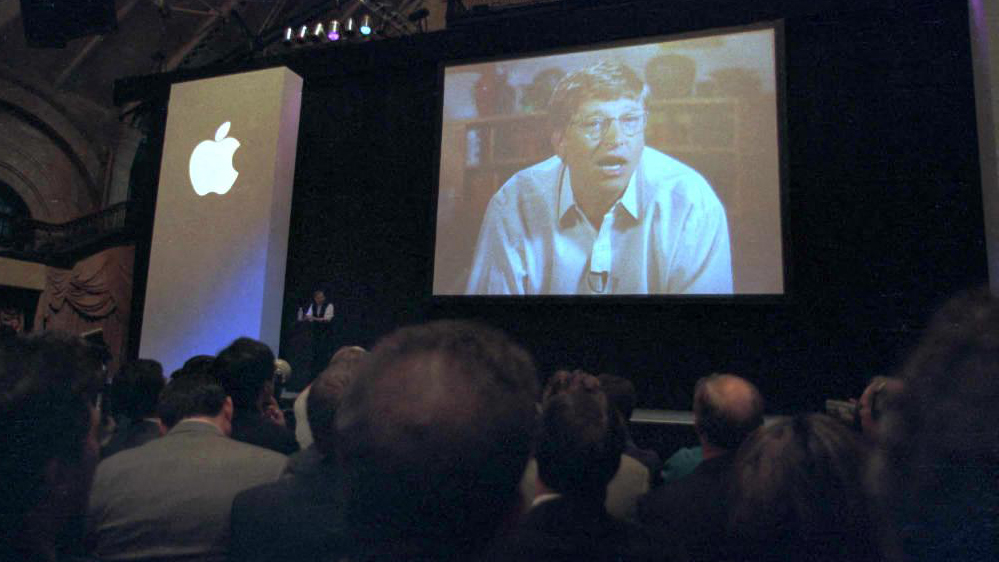On the eve of one more Apple occasion, one during which it introduces a group of iPhone 16 handsets most likely not vastly totally different from the yr earlier than, and the collective know-how client leaps into shopping for motion as a result of, properly, it is Apple, it is value remembering that, maybe, none of this is able to’ve been doable with out an act of charity or calculation by Apple’s as soon as biggest rival: Microsoft.
I used to be reminded of the period when Apple, its heyday within the rearview, was relegated to failed Newton Handhelds, poorly conceived partnerships with Bandai (Pippin recreation console/web equipment), and close to irrelevance.
In the years after Apple co-founder and CEO Steve Jobs was ousted and his return in early 1997, Apple watched its revenues tumble from a excessive of $11 billion to $7 billion. It noticed its losses mounting to $125M in 1996. There was speak of a merger with Sun Microsystems, one which then Apple CEO Gilbert Amelio would not affirm and that spokespeople denied. It was clear although that such speak was additional hampering gross sales of Apple’s then principally lackluster Power Macintoshes and Powerbooks.
While there’s some disagreement on the extent of Apple’s pink ink on the time, even Jobs admitted simply months after his return that there was work to do “to make Apple wholesome once more.” It was throughout that memorable Macworld 1997 presentation that Jobs outlined a plan to convey Apple again. Notably, there wasn’t a single new product announcement; this was all about new management, new, partnerships, and a money infusion from Apple’s largest rival.
What individuals keep in mind about that day is that Microsoft dedicated to purchasing $150M Apple shares (non-voting).
The value of survival
“Yes however the vital a part of this that didn’t get sufficient consideration is that this included an open-ended license for Microsoft to make use of a graphical interface for Windows,” longtime Apple analyst and Creative Strategies chairman Tim Bajarin informed me. Bajarin has been masking Apple nearly since its inception.
People like Bajarin, who knew Jobs and the sorry state of the corporate, cheered the bailout (“it was and strategic win for each”), however not these in attendance at Macworld.
They booed the inventory purchase and different components of the landmark deal (Microsoft promising to launch MS Office for Mac for the subsequent 5 years received a extra constructive response). When Jobs defined that Apple had agreed to make Internet Explorer the default internet browser for Mac, an attendee cried out, “No!”
The response was comprehensible. Apple’s enterprise was constructed on an anti-PC basis, the alternative of Microsoft’s Windows and its extra company worldview. The antagonism as soon as appeared to gas each corporations. But these days had been lengthy gone. As Jobs famous in his presentation, “Relationships which might be damaging don’t assist anybody on this trade as it’s at present.”
Of course, Microsoft was not being fully altruistic. As a part of the deal, Apple agreed to a broad patent settlement and cross-license deal “for all patents, together with these filed within the subsequent 5 years.” This meant Apple wouldn’t go after Microsoft for its use of a too-similar-to-Mac OS GUI interface on any model of Windows.
Putting Internet Explorer on one more platform helped Microsoft cement its quickly rising lead within the internet browser area. I’m undecided that transfer helped it when it confronted an antitrust go well with in 2000.
Within a yr, the worth of Microsoft’s funding just about doubled and solely grew from there.
A deed that paid off

While the explanations for Apple’s fall from grace had been myriad (Jobs described it as “executing splendidly on most of the unsuitable issues”), there was motive to consider that the model may very well be not simply robust, however a possible powerhouse. During his presentation, Jobs described unbelievable model recognition and its enviable market place in training and inventive content material.
In 1997, 64% of all web sites had been, in keeping with Jobs, being designed on a Mac and 60% of all computer systems in training had been Macs. The numbers are all of the extra shocking as a result of, by Apple’s personal depend, it had about 20M prospects. Today the corporate has over 2 billion.
What Apple lacked for greater than a decade, although, was its founder and visionary. Jobs got here with concepts (and the remnants of the NeXT platform). Bajarin believes the money infusion gave Apple time to develop the long-lasting iMac, which shipped in August 1998.
Of course, it gave us excess of that. One may argue that with out Microsoft’s $150M life preserver, Apple may not have survived. It’s doable then that there’d be
- No iPod
- No iPhone
- No iPad
- No Apple Watch
- You get the concept
I am unable to argue that we’d not have gotten there ultimately, however the cell computing revolution may’ve been delayed by 5 or extra years.
Think about it, it solely took $150M to save lots of an organization that might change our lives and ultimately be value trillions.
So, if you’re marveling over the newest iPhone 16, AirPods Pros, and Apple Watches, elevate a glass to Microsoft and, sure Bill Gates, who was heartily booed when he appeared on display at that 1997 Macworld. Without them, the Apple of 2024 may not even exist.
